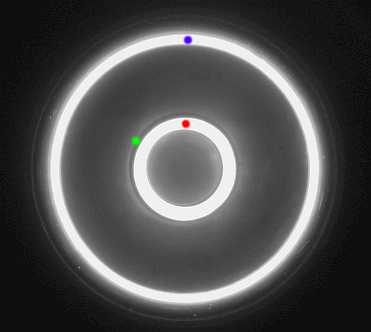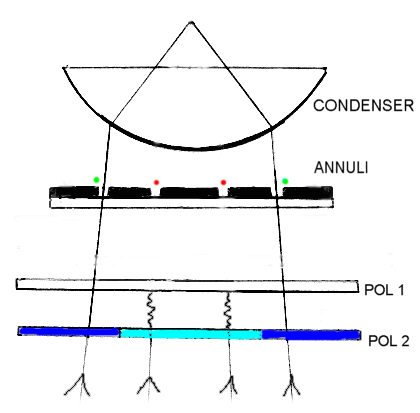 |
| Substage Polar Control Lighting
Unit Preliminary attempts to elicit maximum observational efficiency when studying sensitive aquatic life forms By Paul James |
The frustrations of observing sensitive aquatic life forms are well known, more especially at medium to high power. Often we have little time to scrutinise such fitful examples of ciliates before they decide to scoot off out of the field of view at the slightest disturbance from the adjustment of the microscope's controls, or the sudden change of illumination techniques.
These, and other related problems in microscopy led me to wonder if a microscope could be modified to provide a number of lighting techniques that could be surreptitiously changed from one to another, with no mechanical disturbance whilst being able to keep the eyes on the target too.
The obvious virtues of having all the lighting techniques built into a single substage condenser are of little use if their clunky implementation sends the more sensitive critters into retreat.
AN IDEA
Out of this oft experienced observational frustration spawned an idea which when examined in depth seemed also to have other virtues. Since Phase contrast, Darkfield, and COL are generated by annuli of differing NA., the smooth transition of change of one lighting technique to another could therefore be contrived by using a condenser stop which sports annuli, concentrically aligned in the one Zernicke disc setting for a given phase objective. The trick is to mask the unwanted annuli but leave the desired annulus to function....... this can be done mechanically of course, but there is a better way of controlling the zones of light as well being able to do so without touching the substage condenser where the annuli are housed.
 |
The image above was taken from the back of a x40 phase objective, and shows the COL and the Phase contrast annuli in situ simultaneously. The objective's phase annulus can be seen too. By using Polar Filters, the substage condenser can be left alone after initial setting, as the lighting changes take place from the rotation of one polar element :-
 |
The above diagram is simplified, but shows essence of the switching technique from Phase Contrast to COL . In this setup there are 2 polar planes POL 1 & POL 2. The upper POL 1 sheet covers all the light emerging from the lamphouse. In the lower plane POL 2, the sheet's centre is cut into a circle and turned 90 degrees relative to the outer portion. It's diameter is such that it spans the zone of light that illuminates the phase annulus.
Thus by rotating POL 1, light will alternately pass through the centre zone and outer zone to elicit Phase contrast and COL for each 90 degrees of rotation of POL 1. In fact the transition of one lighting technique to the other will be gradual: smoothly diminishing and increasing for one as the other. Thus both Phase contrast and COL can be raised separately just by rotating the POL 1 through 90 degrees, in either direction.
COL lighting is shown in the diagram above. Only half the light gets through the POL 2's centre zone , and is finally absorbed by POL 1. Since POL 1 and the outer zone of POL 2 are similarly polar orientated, the light passes through. For Phase contrast, the opposite occurs.
A triple lighting arrangement with DF would require 3 polar planes, the upper 2 being manually rotated independently, and one of them wide enough to mask the inner annuli. There are other permutations of course, as well as other ways of tiering the polar film discs, but because of the absorbency of a single pol filter, it is best to keep the number of polar filters to the absolute minimum.
Some Practical Considerations
Since crossed polar film is not entirely effective in blocking light you might find a 'leakage' in an unwanted zone, but the amount getting through from the 'blanked' zone to the image from the selected technique should not be enough to spoil its imagery. There may be some brightening of a DF background but not I'd have thought it sufficient to mar the highlighted specimen.
The best illumination combinations involve those lighting techniques which have similar light level throughput such as Phase contrast, DF, COL, all generated by annuli. Brightfield passes far more light into the specimen for obvious reasons, and is also difficult to pair with any other technique because of this light leakage problem etc., unless it is defaulted to a low NA setting. In any case the bathing of sensitive specimens in bright light is to be avoided, and thus the annular lighting techniques are more suitable for this line of observation.
Polar Modules and Location
The polar 'switching module' can be housed over the field aperture on the stand's base. This has the advantage of convenience of use, and is well away from the stage. Also the zones for the lighting annuli are somewhat larger and so more easily fashioned than they would be if mounted inside the substage condenser. Fortunately the borders between the annuli in the condenser are relatively broad and so the estimating of the polar inner diameters is not too critical. Experimenting with cardboard cut-outs on the field aperture is the best way to proceed to find out the physical dimensions of the polar filters.
Getting Started
I advise anyone who is interested to experiment with just 2 polar tiers. A single polar sheet would provide enough material to fashion the necessary layers. I made use of redundant camera filters, as well as the recess of the field aperture to contrive a practical assemblage of tiered polar module, which can easily affect lighting changes whilst viewing the specimen. When not required the assemblage can be lifted off the base and boxed in seconds.....it's that simple. As I am still in the experimental stages my setup is in a temporary phase, but it looks like it's going to be no bigger than 2 stacked camera filter rings each sporting the POL1 and POL 2 polar films.
Pro's and Con's
Like most contrivances there are advantages and disadvantages. The slight light leakage of crossed polars is inconsequential providing your illuminant's power output is moderate, so it should be no problem. The paradox here is the light is also absorbed by polar film, so the image brightness is a few percent less than normal. This smooth and remote switching technique suits the eye simply because the light levels are modest, though photography is not ruled out.
Odd's and Ends
The substage condenser needs to be focussed and left before critical observation commences. The ideal setting should centre around the most sensitive illumination technique : COL or DF. Condenser focus setting in Phase Contrast, apart from aligning the annulus with the objective's, is fortunately not critical, so the condenser can be left focussed for the former technique(s).
Most Phase Condensers sport extra apertures for other illumination techniques like DIC etc.. These can be used to house your DIY annuli, rather than modify existing proprietary annuli, and so compromise the inherent value of the condenser.
Since a single sheet of Polar film will provide enough material for most applications, the cost of the polar switching unit should amount to no more than around £10-15. If like me you keep all your bits and pieces from the past, the use of redundant camera clear filters to support the polar cut outs should present no problems. You might be able to mount the polar circles in place of the original filter glasses? You could of course have a camera polar filter mounted in a rotating ring assembly which is a good base on which to experiment with extra polar films and their effectiveness.
| All comments welcome by the author Paul James |
Microscopy UK Front Page
Micscape
Magazine
Article
Library
Please report any Web problems or offer general comments to the Micscape Editor.
Micscape is the on-line monthly
magazine of the Microscopy UK web
site at
Microscopy-UK